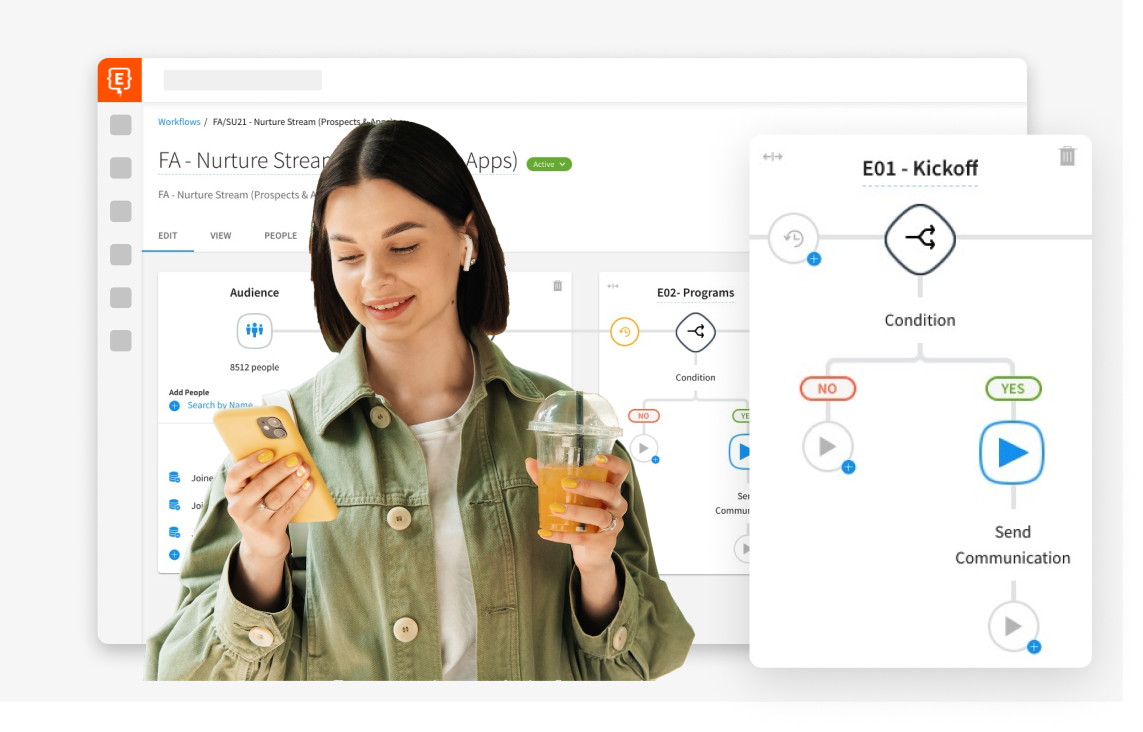Full Guide to Student Success in Higher Ed
Updated Oct 07, 2024

Element451’s Guide to Enhancing the Student Experience from Enrollment to Graduation
The college experience is transformational, taking students on the adventure of discovering new dreams, accomplishing personal goals, and stepping into future endeavors. But being able to run through these life-changing milestones means knowing what success realistically looks like at higher education institutions.
By unlocking the secret of student success, administrators can navigate new challenges, discover practical retention strategies, and leverage the most innovative tools and student engagement software on the market. In this post, we’ll take a comprehensive look at student success in higher education — going beyond basic academic metrics.
Are you ready to help students become the superhero of their own college story? That journey starts now.
What is Student Success in Higher Education?
Student success in higher education is a way to measure and monitor the academic achievement and holistic growth of students throughout their postsecondary education. Success isn't just a measure of classroom performance or graduation rates.
Instead, it goes beyond scholastic activities and focuses on how students relate to their peers, integrate into their community, and access the resources they need for ultimate achievement.
Defining Success for Higher Education Institutions
Having the right definition of student success is dependent upon a school's understanding of:
- Who students are (on a personal level)
- What they expect from the four-year college experience
- Where they turn for support and success resources
Generational trends always influence student success outcomes, but at the end of the day, the best measure of college success is knowing how well students thrive in separate areas of their lives. Acknowledging all of these influences creates a “whole person” approach that’s vital for creating student-first experiences. (Plus, students define success in ways that are unique to their own expectations and perceptions.)
At Element451, we believe that student success is multifaceted, especially for a diverse, flexible, and digitally savvy generation of college students. We look at it like this:
"For the college learner, being a successful student also includes qualities related to support, persistence, community involvement, and interpersonal (as well as academic) experiences. As a result, we can see that student success is more than just a number with a few decimals; instead, it’s the comprehensive way that students perform and persist."
Measure Student Success in the Current Landscape
Does the basic concept of student success stay constant, even as the needs and qualities of modern students change so frequently? To pin down an answer, we need to take a closer look at what the current cohort or generation of students (particularly first-year students) is dealing with.
For example, students struggle academically at many institutions because the delivery method isn’t in line with their learning style. According to Jonathan Malesic, an instructor at Southern Methodist University, over-tired yet under-engaged students became rampant when schools switched to online delivery methods during the COVID-19 pandemic. But some of these trends have persisted even after a return to normalcy, proving that student concerns and worries shape their student experience.
In InsideTrack’s list of higher education trends to watch, college leaders are encouraged to look for current trends among students who are driven and motivated to excel.
- A focus on mental and holistic well-being is predictive of student success.
- Nontraditional students (and older students) have separate needs from traditional groups, and schools must be able to accommodate diverse needs to assist across demographics.
- Students are now prioritizing practicality and career longevity over prestigious institutional pedigrees. This means that schools can offer students more career-related resources to help learners excel through degree attainment.

See Element451 In Action
With its powerful and customizable platform, Element451 can provide an unparalleled level of support to institutions seeking to engage with their students in a more effective and dynamic way.
See How it Works
Factors that Influence Student Success and Persistence
Student success, persistence, and retention don’t happen in a vacuum. Plus, it’s simply not true that only one type of student excels in the collegiate environment.
All students can experience successful degree completion and graduation, but certain factors influence the rate at which that success occurs. Things like quality education, personal relationships, and postsecondary education resources tend to shape (and even predict) the outcome of a student’s journey.
Let’s take a closer look at some of these success factors. In doing so, we'll help your school evaluate how to create roadmaps for success.
Quality and Delivery of Academic Content
In a higher education context, most students pay to receive a top-tier education. While the investment does include living-related factors (such as room and board) and campus extracurricular activities, the most influential aspect is the teaching that they receive in the classroom. Quality hinges on a number of aspects, including selected materials and texts, expertise of the instructor, and evaluation methods.
In the International Journal of Higher Education, researchers studied the effect of content quality on the overall educational experience of college students. They found that:
“Quality instruction means the delivery of instruction in a way that evokes students’ interest, critical thinking, and learning in a meaningful way. It makes students become curious and excited about what they are doing and consequently enables them to discover learning and take ownership of their own education.”
This discovery suggests that it's crucial to teach students high-quality academic material, but it also means engaging them in worthwhile conversations. Adapting to various learning styles allows all students to grasp the subject matter.
The takeaway? Student success depends on quality instruction and engaging communication. The days of boring PowerPoint presentations and non-stimulating lectures are things of the past.
Relational Health and Mental Well-being
Another vital predictor of student success? How students rate their emotional health in the collegiate environment. Factors like community involvement, relationships with peers, and access to mental health networks can change how students rate their own well-being.
New research from Ya-Hsin Hsiao of Western Kentucky University examines the connection between psychological well-being and academic performance among first-year college students, particularly in light of post-COVID academic changes. The study concludes:
“First-generation students' overall psychological well-being scores and their self-acceptance sub scores both positively predicted GPA scores more strongly than these scores for other students.”
In other words, mental well-being is even more influential than other success factors, particularly for first-year students who may be more sensitive to major life changes, academic adjustments, and transitions. Schools that want to promote a greater level of success among student groups must be mindful of the psychological factors that shape and change students’ trajectories.
Student Support Networks and Resources
It’s as true in life as it is for the higher ed experience—going through it alone is risky. When college students find themselves isolated, lonely, and missing out on important college resources, they’re less likely to stick to goals when times get tough.
That’s why so many universities promote materials that help college students build a worthwhile support network. While this system varies by institution, most colleges and universities offer some (or a mixture) of the following resources:
- Residence hall or campus life staff
- Academic advisors (assigned based on academic program)
- Peer-to-peer mentorships
- Members of clubs and student-led clubs or organizations
- Staff and faculty members
- Basic counseling support
- Sports team coaches and leaders
- On-campus emergency personnel
Building a network of support helps students access the academic, social, and emotional resources they need throughout challenging times.
Most importantly, the presence of supportive resources that align with modern student needs is a predictor of long-term success.

4 Tips to Increase College Student Success and Close the Achievement Gap
Now that we have a foundation of student success in college and why it's important, we need a plan to actually get there. While some students are naturally included to create successful habits, others need external incentives. College administrators, faculty, and staff must rise to the occasion to develop success-focused that have the potential to change lives.
Getting started with success initiatives is easier than you think. Begin with first impressions, and move forward with a holistic, long-range view of the student.
Tip 1: Onboard with Excellence
Successful college experiences begin at the first point of interaction. This means that pre-enrollment and admissions processes are just as pivotal to key outcomes as other experiences.
What's the implication? It's an obvious one. Colleges must work hard to bridge the gap for new students to help ease the stress of transition. As InsideHigher Ed points out regarding predictable student success outcomes:
"Successful institutions introduce students to a dedicated advisor. They inform students about campus services and opportunities. They emphasize the institution's commitment to providing students with the support and services they need to succeed. And they offer pre-enrollment bridge programs and boot camps to ensure that students succeed in their first-year classes."
Integrate students into the campus community by over-communicating essential details. The more data points you have on students, the easier it is to accomplish this.
Tip 2: Promote Engagement In and Out of Class
There are two ways to think about success in a university environment, and they revolve around the events that happen for students within and outside of the classroom. In academic environments, students who want to succeed must be:
- Ready to attend all course sections and class meetings
- Attentive to the curriculum and instruction
- Able to collaborate with peers and other students on assignments or discussions
- Equipped to tackle exams and final assessments that measure key learnings
The campus community should be one that instills these values in students so that they can successfully prioritize lessons and responsibilities.
But outside-of-classroom engagement is predictive of success, too. Students should be encouraged to tparticipatein campus activities, join a team or club, and socialize with their peers or ctaff. Although there's a delicate balance between "study and play," the holistic (and healthy) college experience includes both.
Tip 3: Regularly Evaluate Success Metrics and Identifiers
For campus leaders and supervisors, monitoring success metrics regularly is a non-negotiable task. Without careful attention, at-risk students fall through the cracks. But by creating a strategy to analyze and check-in, you can identify risk factors early and keep students moving forward. Over time, these efforts directly improve retention and persistence.
As the characteristics of modern students change, so do the success metrics that are most influential in successful outcomes. For example, many sources point to student mental health as being a prime indicator of higher ed success nowadays. As a result, college and university leaders need proactive systems in place to measure and monitor mental well-being in the student population.
Tip 4: Focus on What Students Actually Value
Effective engagement happens when schools acknowledge the core values that are most important to the current generation. By doing so, college staff can "speak the language" that most resonates with students, in addition to giving those attendees academic and social resources for success.
If you guessed that personalization plays a role here, you're correct. Personalizing school communications, reminders, and interactions ensure that you connect on an individual level. And when students know that their school community holds the same ideals they do, they're more likely to stay committed.
How a Student Engagement Platform Improves Performance and Success
To help students be successful, you must shepherd them through every stage in the student lifecycle, beginning with the enrollment and admissions processes. From those initial exchanges, students form impressions about their place is in the community and about their lasting relationships.
To increase retention rates, staff members must broaden the post-enrollment journey and foster healthier student connections—even after those students are in seats. With a student engagement platform like Element451, you can run personalized campaigns to current students, drive more student referrals, and increase retention with intuitive AI-powered data.
Developing a student-first campus culture means gathering real-time insights, including data from marketing, admissions, and student success teams. By analyzing trends, campus leaders become more equipped to make smarter decisions, reduce friction during student interactions, and create campus-wide alignment among separate departments.
Valuable Success Metrics for Colleges and Universities
Tracking student success with metrics is critical for understanding the trajectory of your students. It’s also impossible to create intervention measures when you don’t understand which activities are causing roadblocks on the degree path.
Here are a few basic metrics that we recommend based on experience with campus engagement and growth.
- Retention rate – Retention rates are calculated annually by dividing the number of retained students by the number of enrollments. This percentage helps school leaders visualize how many students stick with their enrollment commitments. It’s important to scan for multi-year trends or retention “red flags” among student cohorts.
- Academic performance – Most institutions measure academic performance through grade point average (GPA). Many automatic GPA calculators are available for students to calculate on their own. In general, GPA is a collective average of course grades, weighted by the credit assigned to each class.
- Academic progress – Academic progress is typically expressed as a measure or percentage of degree completion over time. Registrar and advising may choose to monitor individual student progress to ensure that students complete a specific number of credits in a given timeframe.
- Non-cognitive scores – Lately, there is growing support for non-cognitive metrics as well, which can be identified through interviews, skills assessments, or other written testing instruments. Non-cognitive abilities don’t show up on exam scores, but they do include essential life skills like motivation, resiliency, motivation, and communication.
- Predictive risk scores – Predictive risk assessments give institutions an early warning when students are at-risk of non-completion. Institutions typically decide their own benchmarks for risk analysis, but the goal is to establish an alert system when students start to struggle academically or socially.

Practical Student Success and Engagement Resources
At Element451, we provide updated higher ed resources and online discussions for engagement-focused schools. From blog posts to webinars, you’ll find comprehensive resources on topics that impact student life.
Check out the resources below to expand your engagement perspective.
Help Your Students Accomplish Goals
As we’ve surveyed what student success is, practical ways to promote it, and metrics to measure it, we hope that you’ll remember the most important piece of the puzzle—real students.
Higher education should be all about changing student lives by building a foundation of success. That’s the central point, and it changes the way we look at collective strategies, implementations, and analytics.
Element451 delivers personalized campaigns and student-focused experiences so that your school can focus on what really matters. If you’re missing this important part of the student engagement journey, we’ll help you close that gap.

About Element451
Boost enrollment, improve engagement, and support students with an AI workforce built for higher ed. Element451 makes personalization scalable and success repeatable.
Categories
New Blog Posts

The Definitive Guide
AI in Higher Education
Bridge the gap between the latest tech advancements and your institution's success.
Useful Links
Related Articles

Talk With Us
Element451 is the only AI Workforce Platform for higher education. Our friendly experts are here to help you explore how Element451 can improve outcomes for your school.
Get a Demo








